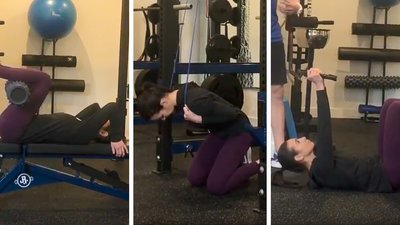Spinal flexion—or the simple act of bending at the lower back—is one of the most highly debated topics in the fitness industry today. On one end of the spectrum we have the ultra-conservative approach, which sits just short of outlawing any spinal flexion in both training and daily life. On the other end, there are the meatheads who put loads of volume and frequency in spinal flexion-based exercises like crunches and sit-ups in their quest for an aesthetic midsection.
So, who's right? Like many things, neither one of these training outlooks on spinal flexion are fully correct, or give a complete picture of the complexities of healthy spinal motion. Yes, if you want to have a strong, pain-free back, you need to learn how to brace! But no, that doesn't mean that the only ab movements you need to do are never-ending planks.
Here are three movements that give you the best of both worlds. They demand and teach proper bracing in a neutral position, but also make your six-pack muscles work overtime. Skip the thousands of crunches a week, and instead use these three core exercises to build a strong and resilient core that also happens to look great in the mirror.
Reverse crunch with foam roller
The traditional reverse crunch is an immensely popular movement to train the rectus abdominis, or six-pack muscles, partially because it reliably gives that feeling of a mind-muscle connection. But, just because you feel the burn doesn't mean you're doing the movement in the best possible way. As the reps pile up—each one sloppier than the last—the outcome is often a pissed-off lower back, and lackluster results as you compensate your way through the movement.
It's easy to make this movement better—and harder—with the simple addition of a foam roller. By placing a foam roller between the calves and the hamstrings, and actively holding it in this region during the reverse crunch, you can maintain neutral spinal and pelvic positions, while still making your entire core work overtime.
The key here is to crunch up only as far as you can keep your back and tailbone in contact with the bench, and no further. In that knees-to-chest position, squeeze as hard as you can, then perform the eccentric lowering moment slowly. This method will skyrocket the levels of muscular tension, reducing the need for a huge amount of reps to feel the movement working.
Upon lowering, ensure that your back does not come up off the bench, and remains in neutral throughout the entire set. For most lifters, rep schemes between 8-12 usually do the trick—provided you're working your ass off to maintain a neutral spine with a full-body brace.
Banded kneeling ab crunch-down
The traditional crunch places lifters on their back, and tells them to actively crunch their head, shoulders, and spine up against the resistance of gravity. However, having the knees and feet dangling in the air unsupported in a 90-degree hip flexion position is less than ideal for spinal stability.
That's why I prefer to stabilize the lower body, including the ankles, knees, hips, pelvis, and lumbar spine, and perform crunch variations in a kneeling position. My move of choice? The banded kneeling ab crunch-down.
But before we talk about loading the kneeling crunch, let's ensure you're starting in an optimal position to stabilize and control this movement. Place your knees just outside of shoulder-width apart, with slight hip external rotation, or the feet slightly closer together than hip-width. This position essentially places the hips in a perfectly centrated position in order to work with the pelvis and spine to stabilize the entire midsection. From there, move the hips back toward the feet while the entire system is actively stabilized through squeezing the glutes and adductors together.
The addition of banded accommodating resistance allows more loading in the stronger positions of the crunch, and less loading where the spine is more vulnerable for losing its base stabilized position. Still, it's essential that the vast majority of the crunching action is coming from the thoracic or upper spine, moving toward the rib cage down toward the ground, as opposed to fulcruming at the lower back, which is a common fault.
As you crunch, squeeze your abs hard and return to the starting position under a ton of tension and control. Stay within 10-20 reps here with controlled execution.
Supported 90-90 plate press
As I mentioned above, having the feet and knees hanging out in what's known as an "open chain" setup is less than ideal for maintaining neutrality at the lower back. But, there are still advantages to training in a bent-hip position in order to isolate and activate the front side of the core.
So, how do you get the best of both worlds? Simply add a bench under the feet and lower legs to stabilize this hip flexion position. That's the basis for the supported 90-90 plate press.
I learned this exercise nearly 20 years ago as a smarter way to load the crunch that reduces unwanted spinal shear loading, while also moving the abdominals and core into flexion. Once the feet and legs are set in their supported position, place a weight plate in the hands, extending out directly in front of the chest with the arms straight and at a perpendicular angle to the ground.
From here, press the plate straight toward the ceiling, with a majority of the flexion movement again coming from the rib cage and thoracic spine, closing down their positions to generate tension through the front side of the body.
Since this is a loaded movement, you can progress it easily by using heavier weight plates over time. This movement is best trained in the traditional hypertrophy set and rep schemes between 8-15 reps per set. Use the mindset of progressive overload, not just adding more reps, which is a common mistake with core training.
Keep continuous control over the loads with high amounts of internal tension, and this supported crunch will quickly become a new staple in your programming.

